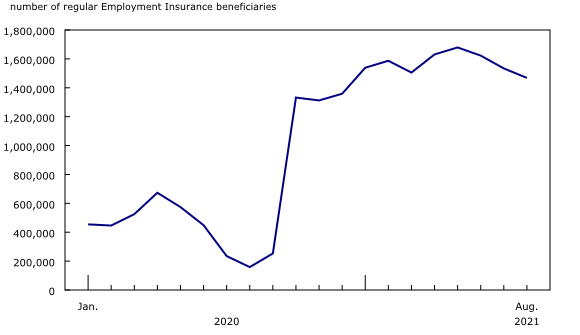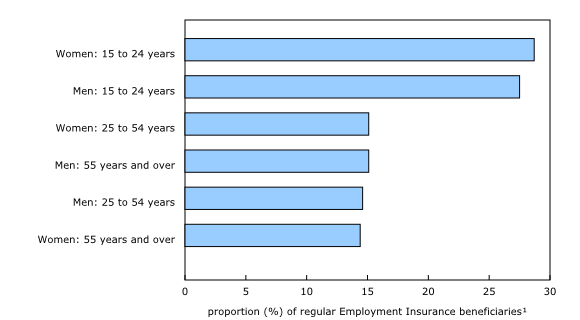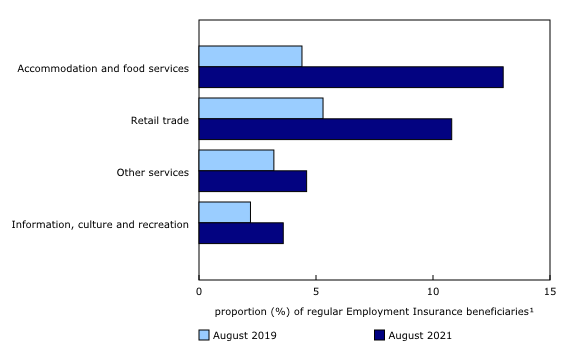Employment Insurance, August 2021
Archived Content
Information identified as archived is provided for reference, research or recordkeeping purposes. It is not subject to the Government of Canada Web Standards and has not been altered or updated since it was archived. Please "contact us" to request a format other than those available.
Released: 2021-10-21
The number of Canadians receiving regular Employment Insurance (EI) benefits dropped 65,000 (-4.3%) in August to 1.5 million. Ontario and Quebec accounted for most of the national monthly decrease.
August EI statistics reflect labour market conditions during the week of August 15 to 21.
By mid-August, most jurisdictions in Canada had lifted most remaining public health measures. Indoor locations, such as restaurants, recreation facilities, personal care services, retail stores, and entertainment venues, were generally permitted to be open, with varying degrees of capacity restrictions. In addition, for the first time since March 2020, fully vaccinated non-essential travellers from the United States were allowed to enter Canada without quarantine requirements on August 9, expanding potential clientele for businesses in tourist areas.
Fewer Canadians collect regular EI benefits in August
Approximately 1.5 million Canadians received regular EI benefits in August, down 65,000 (-4.3%) from a month earlier.
According to the Labour Force Survey (LFS), employment rose by 90,000 in August, while unemployment fell to 1.4 million, including 1.3 million Canadians who were looking for work and 100,000 who had a connection to a job, either because they were on temporary layoff or had arrangements to begin a new job in the near future.
Youth more likely than other age groups to qualify for regular EI under temporary rules
In late September 2020, temporary changes to the EI program, including a reduction in the number of insured hours required to qualify for benefits, were introduced to increase EI eligibility. In August 2021, 16.6% of regular EI recipients—including more than one-quarter of young women (28.7%) and young men (27.5%) aged 15 to 24—qualified under these new eligibility criteria (not seasonally adjusted). Almost one-fifth (18.2%) of regular EI recipients who last worked in either retail trade or accommodation and food services qualified for the program under the temporary rules (not seasonally adjusted).
The decrease in regular EI beneficiaries is concentrated in Ontario and Quebec
The number of regular EI beneficiaries fell in six provinces in August, led by Ontario (-35,000; -6.4%) and Quebec (-19,000; -5.6%). According to August LFS results, employment rose in Ontario (+53,000; +0.7%) and was little changed in Quebec.
At the same time, there were more regular EI beneficiaries in New Brunswick (+3,000; +5.1%), Prince Edward Island (+1,000; +6.3%) and Newfoundland and Labrador (+800; +1.5%).
On a regional basis, a large majority (93.2%) of the decrease in regular EI recipients occurred in census metropolitan areas (CMAs) (-61,000; -6.0%). The Toronto CMA accounted for more than one-quarter (27.4%) of the decrease in total regular EI recipients. August LFS results indicated that employment increased by 73,000 in the Toronto CMA.
One-third of regular EI recipients last worked in sales and service occupations
Reflecting easing public health measures, the number of regular EI recipients declined in 8 of the 10 broad occupational groups compared with July, with the largest decrease among those who last worked in sales and service occupations (-36,000; -6.8%). At the same time, there was little change in the number of regular EI recipients who last worked in either health occupations or in natural resources, agriculture and related production occupations.
Despite falling in the month, those who last worked in sales and service occupations accounted for one-third (33.3%) of regular EI recipients in August, compared with 14.9% in August 2019.
Almost one-third of regular EI recipients last worked in industries providing in-person services
In August 2021, almost one-third (31.9%) of regular EI recipients last worked in one of four industries involved in providing in-person services: 13.0% in accommodation and food services; 10.8% in retail trade; 4.6% in other services; and 3.6% in information, culture and recreation (not seasonally adjusted). With public health measures easing across the country by late summer, there were 28.3% fewer (-186,000) regular EI recipients who last worked in these four industries in August compared with May (not seasonally adjusted). August LFS results showed that the gap between August employment and pre-COVID employment in February 2020 in these four industries narrowed from 664,000 in May 2021 to 339,000 in August 2021.
Bigger drop in regular EI beneficiaries among women than men
In August, the number of women receiving regular EI benefits fell by 38,000 (-5.3%), almost 1.5 times greater than the decrease among men (-28,000; -3.4%). August LFS results showed that unemployment among women fell by 44,000, compared with a 37,000 decrease among men.
The decrease in the number of young women (aged 15 to 24 years) (-6,000; -5.8%) receiving regular EI benefits was more than 1.5 times greater than the decrease among young men (-4,000; -3.0%). According to the August LFS, employment among young women essentially returned to its February 2020 level for the first time.
Long-term unemployment reflected in regular EI benefits
In August, reflecting the challenges faced by many workers in returning to employment, almost two-thirds (64.4%) of EI recipients had received regular EI benefits or the Canada Emergency Response Benefit (CERB) in at least 7 of the last 12 months, up from 16.1% who received regular EI benefits in February 2020. Over two-thirds (69.1%) of men received regular EI benefits or CERB in at least 7 of the last 12 months, compared with 60.2% of women. Among longer-term regular EI recipients, over half (57.2%) were core-aged (aged 25 to 54 years) (not seasonally adjusted).
By province, the proportion of EI recipients who had received regular EI benefits or CERB in at least 7 of the last 12 months ranged from 58.7% in Manitoba to 68.9% in Newfoundland and Labrador (not seasonally adjusted).
August LFS results showed that 27.4% of all unemployed had been continuously out of work for 27 weeks or more, compared with 15.6% in February 2020.
Next release
Information on the profile of regular EI recipients for the week of September 12 to 18 will be released on November 18, 2021.
Sustainable Development Goals
On January 1, 2016, the world officially began implementing the 2030 Agenda for Sustainable Development, the United Nations' transformative plan of action that addresses urgent global challenges over the following 15 years. The plan is based on 17 specific sustainable development goals.
Employment Insurance statistics are an example of how Statistics Canada supports reporting on global sustainable development goals. This release will be used to help measure the following goal:

Note to readers
Employment Insurance in the context of broader COVID-19 benefit programs
No methodological changes were made to the Employment Insurance Statistics (EIS) program over the COVID-19 pandemic period. EIS reflect the Employment Insurance (EI) program for the Labour Force Survey (LFS) reference week in each month.
Data for the October 2020 reference period and onward comprise individuals who obtained EI benefits, and exclude beneficiaries of the Canada recovery benefits (Canada Recovery Benefit, Canada Recovery Caregiving Benefit, and Canada Recovery Sickness Benefit).
Concepts and methodology
The analysis focuses on people who received regular EI benefits related to job loss.
EI statistics are produced from administrative data sources provided by Service Canada and Employment and Social Development Canada. These statistics may, from time to time, be affected by changes to the Employment Insurance Act or administrative procedures.
EI statistics indicate the number of people who received EI benefits and should not be confused with LFS data, which provide estimates of the total number of unemployed people. There is always a certain proportion of unemployed people who do not qualify for benefits. Some unemployed people have not contributed to the program because they have not worked in the past 12 months or their employment was not insured. Other unemployed people have contributed to the program, but do not meet the eligibility criteria, such as workers who left their jobs voluntarily or those who did not accumulate enough hours of work to receive benefits.
All data in this release are seasonally adjusted, unless otherwise specified. Values for all series from March 2020 to August 2021 have been treated as outliers in determining a seasonal pattern for seasonal adjustment. For more information on seasonal adjustment, see Seasonally adjusted data – Frequently asked questions.
The number of regular EI beneficiaries for the current month and the previous month is subject to revision.
The number of beneficiaries is a measure of all people who received regular EI benefits from August 15 to 21. This period coincides with the reference week of the LFS.
Beneficiaries who qualified for EI under the new EI rules introduced in September 2020
Temporary changes to the EI program that provided all new regular EI beneficiaries with a one-time credit of 300 insurable hours were introduced on September 27, 2020. In addition, the unemployment rate used to calculate their eligibility and entitlement weeks was 13.1%, unless their region's unemployment rate was higher.
This supplementary indicator presents the number of individuals who qualified for EI, only as a result of these program changes.
EI beneficiaries by industry
The industry of EI beneficiaries is determined by integrating EI data with record of employment administrative data. For beneficiaries with more than one record of employment in the 52 weeks prior to the reference week, the records with the greatest number of hours are used. If no industry information can be found, industry information is deemed "Not classified" for the beneficiary.
EI beneficiaries by number of months on EI or Canada Emergency Response Benefit over the previous 12 months
This supplementary indicator presents the number of regular EI recipients who received either regular EI benefits or the Canada Emergency Response Benefit (CERB) for a defined number of months over the previous 12 months.
A census metropolitan area (CMA) or census agglomeration (CA) is formed by one or more adjacent municipalities centred on a population centre. A CMA must have a total population of at least 100,000. A CA must have a population of at least 10,000. See Standard Geographical Classification 2016 – Definitions for more information.
Data availability
In the data tables 14-10-0004, 14-10-0005, 14-10-0007 and 14-10-0008, for the March to September 2020 reference periods, data have been suppressed because a source data file contains records for CERB claimants and beneficiaries who could not be identified and excluded through processing.
Historical revision of Employment Insurance data
Seasonally adjusted series of EI statistics have been revised back to January 2017 to reflect the most recent seasonal patterns.
Data tables 14-10-0004, 14-10-0005, 14-10-0007 and 14-10-0008 exclude data for March to September 2020 because a source data file contains records for CERB claimants and beneficiaries who could not be identified and excluded through processing.
Data tables 14-10-0336 and 14-10-0337, which include information on EI recipients by occupation, have been updated to include data from December 2019 to August 2021.
Next release
Data on EI for September will be released on November 18, 2021.
Products
More information about the concepts and use of Employment Insurance statistics is available in the Guide to Employment Insurance Statistics (73-506-G).
Contact information
For more information, or to enquire about the concepts, methods or data quality of this release, contact us (toll-free 1-800-263-1136; 514-283-8300; STATCAN.infostats-infostats.STATCAN@canada.ca) or Media Relations (613-951-4636; STATCAN.mediahotline-ligneinfomedias.STATCAN@canada.ca).
- Date modified:






